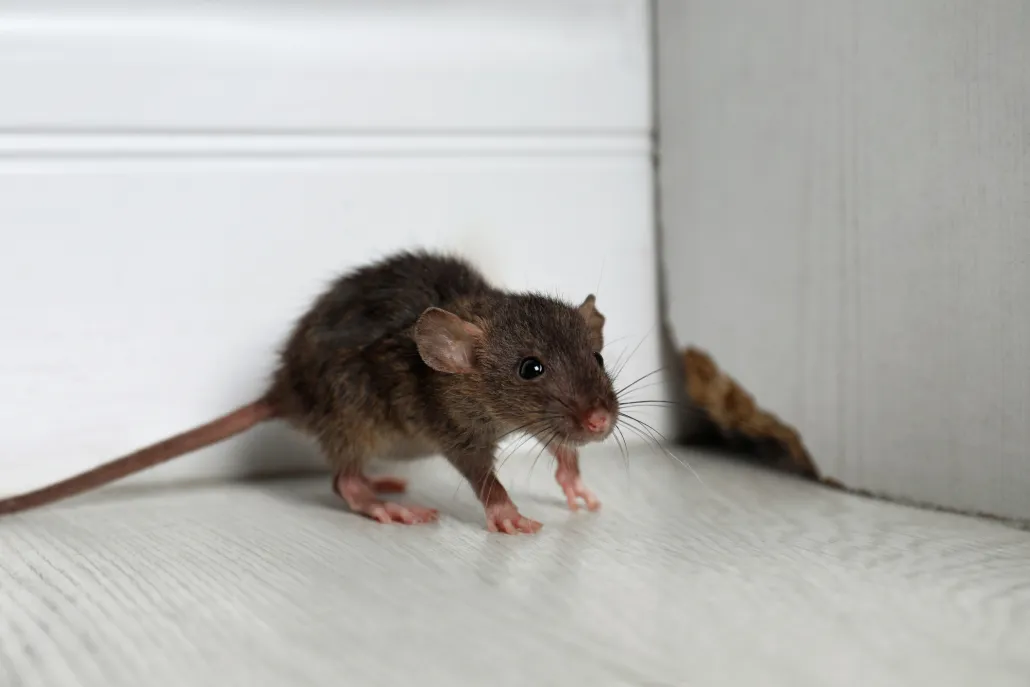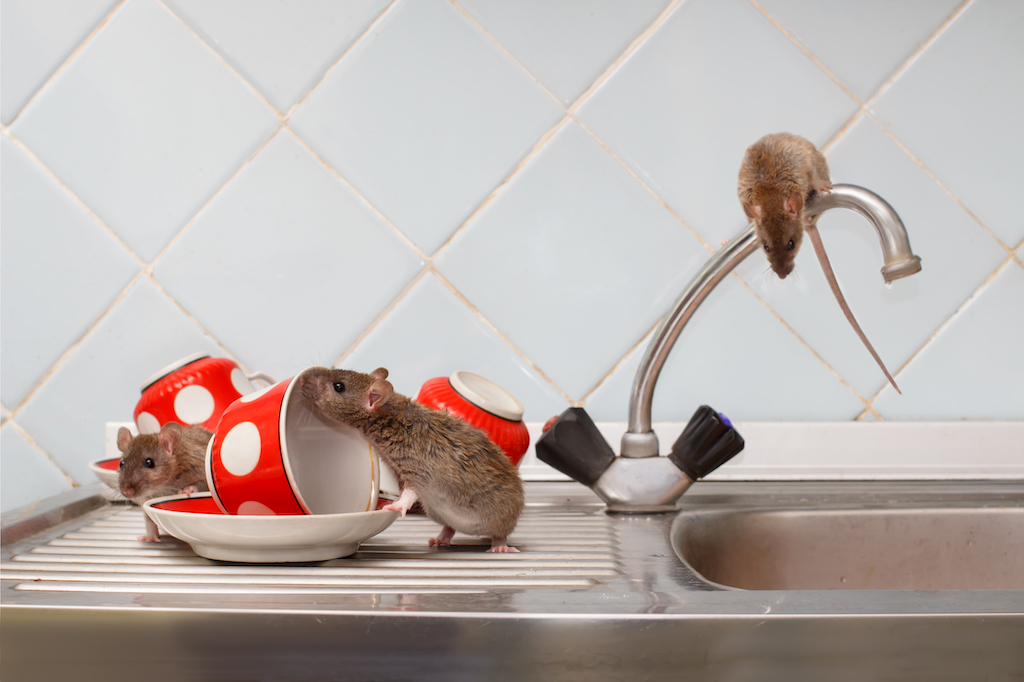Rodent Treatments in Florida
Exterminator Services for Clermont, Groveland, Mascotte, Oakland, and Montverde
Florida’s warm subtropical climate, known for mild winters and frequent rainfall, suits not only residents but also rodents. Mice and rats, in particular, can find abundant food sources, shelter, and comfortable temperatures year-round, allowing them to reproduce steadily. In communities like Clermont, Groveland, Mascotte, Oakland, and Montverde, neglecting early signs of rodent activity invites rapidly expanding infestations, from scurrying noises at night to gnawed wiring or droppings in pantries. This service page clarifies why rodents thrive in Florida’s environment, how to detect a brewing invasion, and why contacting a professional exterminator for rodent treatments remains the most direct path to a rodent-free property. Acting quickly spares you the stress, health risks, and structural damage that rodents can cause when they settle behind walls or under floors, out of view.
Why Rodents Flourish in Florida

- Mild, Short Winters
In colder states, extended stretches of freezing weather curb rodent populations for months, limiting breeding until the climate warms. By contrast, Florida’s winter rarely falls below freezing, denying rodents such natural slowdowns. Indoors, heating and air conditioning preserve stable temperatures that let rodents remain active, reproducing nearly all year. - Frequent Rain and Humidity
Rats and mice seek steady water sources, and Florida’s frequent rainfall plus humidity keeps soils and corners damp. Condensation near air conditioners or small leaks under sinks ensure rodents never lack hydration. When heavy rains flood outdoor burrows, mice or rats can migrate indoors for dryness, exploiting even tiny gaps around plumbing lines or door thresholds. - Near-Constant Food Opportunities
Rodents eat almost any available organic matter: from leftover kitchen scraps to poorly sealed pantry items, unprotected pet food bowls, or open trash bins. In southwestern Florida, with mild winters and year-round occupant routines, a single oversight—a bag of rice left open in a cabinet—can sustain multiple rodents. Over time, stable access to food encourages them to nest in unseen areas. - Minimal Seasonal Dormancy
Harsh winter climates can slow rodent breeding cycles substantially. Florida’s mild conditions impose no such forced break, letting a few infiltrating rodents produce multiple litters uninterrupted. A small infiltration can thus balloon within weeks if occupant diligence in storage, sanitation, or building maintenance lags. - Population Movement
Areas like Clermont attract new residents or short-term renters, often transferring goods in boxes or secondhand furniture from possibly rodent-infested places. Once a few rodents discover a building’s warmth and sustenance, they settle in, expanding quietly until occupant sightings prompt professional intervention.
Telltale Signs of a Rodent Infestation
- Droppings and Urine Trails
Mice leave rice-shaped pellets, whereas rats produce larger, capsule-like droppings. Both types often appear in cabinets, under sinks, or along baseboards where rodents feed or travel. Fresh droppings are moist, turning dry or crumbly over time. The presence of musty smells or stained surfaces can also indicate rodent urine traces. - Gnaw Marks and Holes
Rodents chew tirelessly to file their incisors. This gnawing leaves tiny bite marks on cardboard boxes, edges of plastic containers, or even cables and wires. If you find small holes in cereal packaging or newly drilled holes near corners of rooms, rodents may be the culprit. - Nocturnal Sounds
Mice and rats often venture out under cover of darkness. Faint scratching, squeaking, or scampering in walls, attics, or crawl spaces at night strongly suggests rodent activity. Tracking where these noises concentrate helps locate potential nests or runways. - Nests of Shredded Material
Rodents gather soft, fibrous materials—paper, fabric, insulation—to form nests in concealed corners (like storage rooms, behind large appliances, or rarely accessed closets). Droppings or leftover seeds near these piles confirm active rodent living quarters. - Strange Pet Behavior
Dogs or cats might fixate on walls, floors, or cabinets where they detect rodent movement or smells. If your pet insists on pawing a specific baseboard or corner, checking for droppings or chew marks could reveal hidden rodents.
Dangers of Ignoring Rodents
- Health and Sanitation Hazards
Rodents can contaminate surfaces and stored goods with droppings, urine, or fur, risking bacteria or viruses that cause disease. They may also bring fleas or ticks indoors. Quick removal helps maintain occupant well-being and hygienic conditions. - Structural and Wiring Damage
Gnawing on wooden beams, drywall, or insulation degrades a building’s integrity over time, potentially leading to costly repairs. Chewed wires, in particular, can spark electrical shorts or fires, heightening occupant risk if not promptly addressed. - Rapid Population Growth
A single pair of mice can produce multiple litters each year, quickly overflowing hidden corners or behind walls if occupant vigilance is low. Each new litter intensifies droppings, gnawing, or contamination issues, complicating eventual treatments. - Stress and Inconvenience
Living with scurrying noises at night or discovering droppings in kitchen drawers undermines occupant comfort. Swift, thorough extermination spares families or businesses prolonged anxiety over unseen rodents rummaging about daily spaces.
Why a Professional Exterminator Is Indispensable
- Accurate Inspection and Species Identification
An experienced exterminator recognizes whether you’re dealing with house mice, roof rats, or larger species, guiding the approach. Distinctions in nesting preferences or typical runways help tailor the plan—like focusing on attics for roof rats or behind kitchen appliances for mice. - Comprehensive Trapping and Baiting
Relying on store-bought traps can scatter rodents deeper into walls if incorrectly placed. Professionals know exactly where to install snap traps, multi-catch devices, or bait stations for maximum rodent contact while minimizing occupant or pet exposure to chemicals. - Sealing Entry Points
Exterminators often highlight crucial steps, such as using steel wool or caulk around pipe inlets, upgrading door sweeps, or patching foundation cracks to deny rodents new or repeated access. By sealing holes as small as a dime, occupant synergy with professional advice cements rodent-free outcomes. - Sanitation and Structural Corrections
Beyond immediate rodent removal, occupant housekeeping—like storing cereals in sealed containers, removing clutter, or disposing of kitchen waste daily—keeps rodents from re-colonizing. Professional recommendations regarding yard upkeep (like removing debris piles) hamper outside nesting near a property’s foundation. - Follow-Up Verification
Because rodents reproduce quickly, scheduling re-checks helps confirm no newly born mice or rats remain. If occupant sightings continue, additional measures—like repositioning traps or intensifying baits—finalize eradication. This diligence spares property owners from partial success overshadowed by a second wave of rodents.

Methods for Rodent Treatments
- Detailed Property Assessment
Locating droppings, gnaw marks, or nest debris reveals high-traffic routes. Checking subfloors, attics, or basements for droppings or a stale smell often indicates hidden rodent enclaves. Identifying rodent species (mouse vs. rat) clarifies trap size and bait selection. - Indoor Traps and Bait Stations
Snap traps placed flush against walls exploit mouse or rat travel paths. Bait stations containing rodenticides can be discreetly positioned in locked enclosures, safe from children or pets, ensuring rodents ingest slow-acting poison that kills entire colonies when they return to nests. - Exclusion Tactics
Because re-entry is common if holes remain, professionals advise occupant-based repairs—installing weatherstripping on exterior doors, stuffing steel wool in pipe gaps, or sealing foundation cracks. This synergy of occupant diligence plus extermination ensures a rodent-free zone moving forward. - Sanitation Upgrades
Occupants must store foods in sealed plastic or metal containers, discard cardboard piles or clutter, and fix dripping taps. Eliminating easy meals denies rodents the resources needed to proliferate, channeling them toward traps or bait. - Outdoor Measures
Some rodents approach from yard edges or neighboring lots. Exterminators may place tamper-resistant bait stations outdoors around property perimeters or near suspected rodent burrows. Removing yard debris or limiting standing water also deters rodent harborages.
Serving Clermont, Groveland, Mascotte, Oakland, and Montverde
Clermont: Known for rolling hills and lakefront neighborhoods. Construction expansions can displace rodents, driving them indoors if occupant vigilance slips. Routine occupant-based checks plus quick sealing of foundation or door gaps hamper infiltration across multiple floors.
Groveland: A growing suburban–rural mix featuring farmland, older properties, and new subdivisions. Rodents can relocate from disturbed land to fresh developments if occupant housekeeping or structural sealing remains incomplete. Swift occupant or landlord synergy stops expansions.
Mascotte: A smaller community where farmland edges meet residential roads. Mice or rats might lurk in outbuildings, basements, or the corners of older homes. Quick occupant detection—like scanning for droppings or nighttime rustling—enables swift professional solutions.
Oakland: Known for scenic routes and older housing. If occupant routine cleaning or crack repairs are minimal, rodents slip through tiny holes. Regular occupant checks—particularly in attics or rarely used rooms—plus sealing and baits unify to deliver rodent control.
Montverde: A tranquil lakeside region with partial occupant presence. If seasonal homes remain unoccupied, rodents can nest unchallenged, gnawing wires or contaminating stored goods. Caretaker-based checks and occupant synergy upon returning hamper rodent entrenchment.
Why Our Rodent Treatments Excel
- Florida-Focused Expertise
Because southwestern Florida lacks the freezing winters that slow rodents elsewhere, we account for near-constant breeding cycles. By merging occupant housekeeping with well-placed traps or tamper-resistant baits, we remove rodent populations quickly and thoroughly. - Precision for Occupant Safety
We set traps or rodenticides in the rodent traffic lines—like behind stoves or along baseboards—rather than blanketing entire rooms. Occupants face minimal exposure to chemicals, and rodents face lethal routes at every turn. - Sealing and Structural Guidance
Beyond immediate removal, occupant synergy—patching cracks or installing door sweeps—blocks fresh rodents from reappearing. This approach cements long-term outcomes, as no new waves can replace those exterminated.
Re-Check Commitment
Because mice or rats reproduce swiftly, scheduling a second inspection or occupant-based observation ensures no overlooked nest remains. If occupant sightings continue, we intensify or reposition traps until all rodents vanish entirely.

Next Steps
Spotting droppings in drawers, hearing nocturnal gnawing behind walls, or finding gnaw marks on stored goods? Contact us to learn more or schedule your service. Our rodent treatments in Clermont, Groveland, Mascotte, Oakland, and Montverde identify where rodents hide, remove active infestations, and guide occupants on preventing future invasions. Partnering with a professional exterminator spares you from the persistent stress of hidden mice or rats rummaging at night, ensures occupant well-being, and preserves property integrity.
Quick, decisive action saves you from potential wiring damage, contamination of stored foods, or occupant anxiety. With occupant collaboration—like discarding clutter, storing cereals carefully, and sealing holes—rodents run out of safe spaces, encountering lethal baits or traps. The result: a rodent-free building, calmer nights, and the confidence that your southwestern Florida home or business stands secure against silent scurrying intruders.
Sustaining a Rodent-Free Living or Workspace
After successful removal, a few occupant-driven measures forestall any rodent reappearance:
- Store Foods Properly: Use sturdy plastic or metal containers for cereals, grains, or pet foods. Immediately wipe counters of crumbs. Mice bypass areas lacking easy meals.
- Remove Debris: Minimizing clutter in garages, basements, or closets deprives rodents of hidden nesting sites. Keep floors around walls open for easy occupant checks and quick detection of droppings.
- Fix Leaks and Drips: Mice or rats hunt for water. Repair dripping faucets, drain AC condensation lines properly, and ensure no standing water near the foundation.
- Close Gaps: Weatherstrip doors, seal pipe inlets, and patch foundation cracks to deny new rodents entry. A dime-sized hole can accommodate a mouse; occupant vigilance is crucial.
- Routine Inspections: Check corners, under sinks, or in lesser-used rooms monthly for fresh droppings or nesting scraps. If suspicious evidence arises, early occupant intervention plus a quick professional revisit halts expansions.
These occupant habits, combined with robust rodent control solutions, protect southwestern Florida properties from repeated incursions. While mild winters, humidity, and abundant resources allow rodents to prosper, occupant diligence plus professional extermination swiftly eliminates them, preserving a serene environment across Clermont, Groveland, Mascotte, Oakland, and Montverde.
